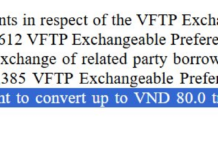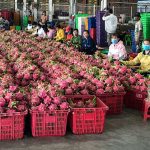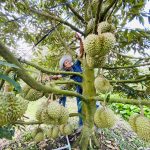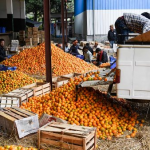Ace in the Hole for Fruit and Vegetable Exports
According to preliminary statistics from the Vietnam Fruit and Vegetable Association (Vinafruite), in June 2024, fruit and vegetable exports reached approximately $800 million, a 20.84% increase compared to the same period last year. Cumulatively, from the beginning of the year until the end of June 2024, fruit and vegetable exports brought in $3.5 billion, a 30.6% increase year-on-year. Notably, durian accounted for $1.5 billion of this total.
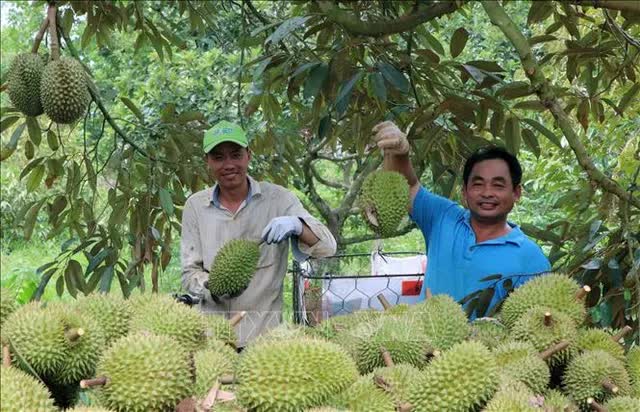
Durian, the “queen of fruits” in Vietnam, has been creating a buzz in regional and global markets.
In fact, durian, the “queen of fruits” in Vietnam, has been making waves in regional and global markets. Based on the bustling order volume since the beginning of 2024, Dang Phuc Nguyen, Secretary-General of the Vietnam Fruit and Vegetable Association, predicted that Vietnam aims to achieve a revenue of $3.5 billion from durian this year, a 55% increase compared to last year. “In addition to exporting fresh fruit, businesses have focused on increasing the volume of frozen durian, processed products, and dried durian, which have also seen significant growth,” added Mr. Nguyen.
At this time, the Mekong Delta is nearing the end of its durian harvest season, while the Southeast region is in the middle of its peak season. Meanwhile, the Central Highlands is preparing to begin its harvest. It’s evident that durian is available almost year-round, which is a competitive advantage for Vietnam compared to other exporting countries. It is known that the durian growing area in the Central Highlands is twice as large as that in the Mekong Delta, so the durian yield in August and September is abundant, potentially pushing fruit and vegetable exports up by billions of dollars per month. Another advantage of Central Highlands durian is that it bears fruit in the off-season compared to other exporting countries, hence commanding a price twice as high as that of the Mekong Delta and the Southeast.
Securing the Top Spot in a Market of a Billion People
According to HSBC, in recent years, global durian demand has increased by 400%, largely due to growing consumption in China. For the Chinese, durian is a luxurious gift and a symbol of opulence and a feast for the senses. The signing of the Protocol on Durian Export to China between the Ministry of Agriculture and Rural Development of Vietnam and the General Administration of Customs of China has elevated durian to a billion-dollar industry.
In the first quarter of 2024 alone, Vietnam surpassed Thailand to become the leading exporter of durian to China, with a volume of 32,750 tons worth $161 million, a 2.4-fold increase in volume compared to the same period last year. Vietnam’s market share in China, in terms of revenue, has increased from 32% in 2023 to 57%.
Currently, Vietnamese and Chinese authorities have finalized technical negotiations to sign a protocol for the export of frozen durian and fresh coconuts to China, after which they will agree and sign the protocol. If China agrees to import frozen durian, the export value of durian will increase significantly. This is because a container of frozen durian exported to China will be worth several times more than fresh fruit exports. Additionally, the implementation of the Regional Comprehensive Economic Partnership (RCEP) has facilitated cross-border transportation. Vietnam’s increased durian exports to China through land border gates will save time and costs, making Vietnamese durian more price-competitive compared to similar products from Thailand. The Vietnam Fruit and Vegetable Association shared that even though it’s only the beginning of the durian harvest season in the Central Highlands, the market is already “hot” due to strong orders and consumption from China, promising another year of Vietnamese durian penetrating deeper into this market of a billion people.
However, the General Administration of Customs of China has recently announced a ban on durian imports from 18 growing areas and 15 packaging facilities in Vietnam due to the detection of heavy metal residues exceeding the permitted limits. This decision comes as Vietnamese durian faces competition from Malaysian durian, as Malaysia has recently been granted permission to export fresh durian to China for the first time. Some analysts suggest that China’s suspension of durian imports from certain regions in Vietnam could be a significant opportunity for Malaysia and may pose challenges for Vietnamese durian exports. Therefore, Vietnamese businesses must maintain quality and focus on enhancing the national brand to firmly establish a large market share in China.
Deep Processing to Expand Export Markets
To achieve breakthrough and sustainable growth in durian exports, bringing high economic value, it is essential to maintain quality, ensure food safety requirements, and for businesses to adopt technology in production, processing, packaging, and preservation. “Businesses and farmers need to strengthen linkages, comply with the standards and regulations of importing countries, especially in maintaining price stability. It is necessary to continue technical improvements and enhance quality to create opportunities for market expansion. In addition to exporting fresh durian, businesses should explore deep-processed products such as frozen pulp and diversify their offerings to develop markets in countries like Japan, the US, Canada, and Australia, reducing dependence on the Chinese market,” emphasized the representative of the Plant Protection Department (Ministry of Agriculture and Rural Development).
Additionally, many exporting businesses hope that the state management agencies will provide policies, regulations, and standards before exporting and guide farmers on technical processes to minimize the risk of quality inspections by partners during the procurement process.
Notably, the rapid export growth has led to a “feverish” increase in durian growing areas, disrupting planning on a large scale and posing risks in quality control, supply-demand imbalance, and adverse effects on both growers and exporting businesses. Therefore, the agriculture industry advises growers to implement new planting, replanting, and crop conversion in accordance with local orientations and to refrain from new planting, replanting, or converting perennial crops to chase market prices.
The Most Popular ‘Billion-Dollar Gem’ Owned by 2/3 of the World, Vietnam Rakes in Over $5 Billion in 2023, What Makes It So Popular?
China continues to have a strong demand for this Vietnamese product, accounting for over half of the market share by 2023.











